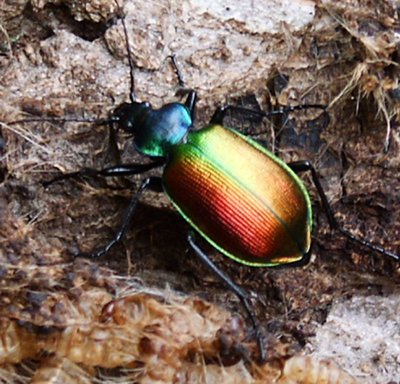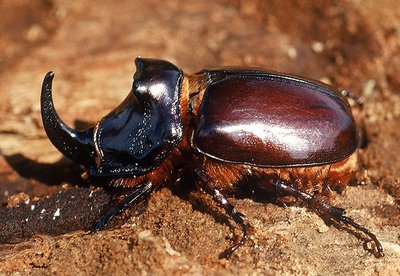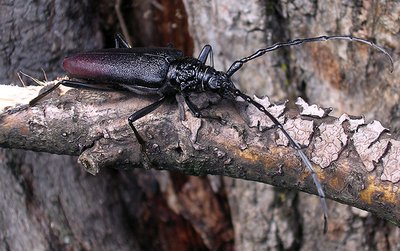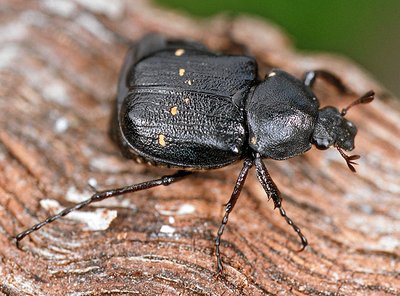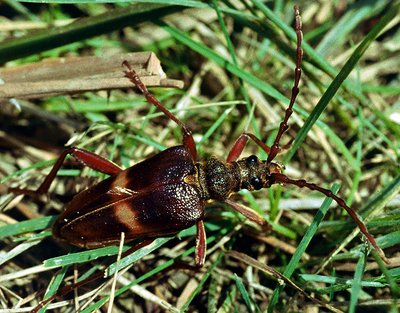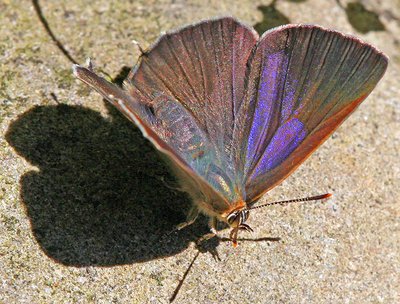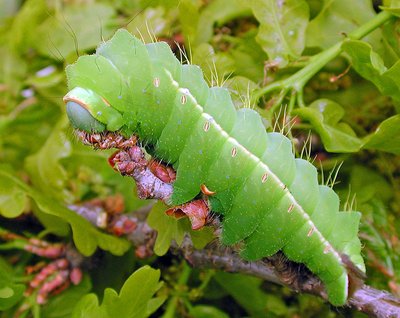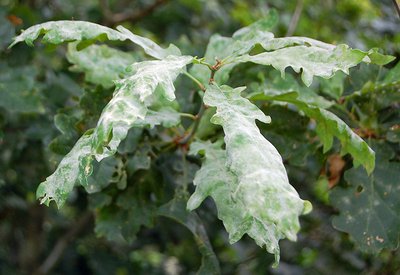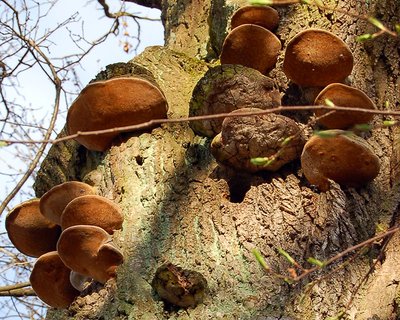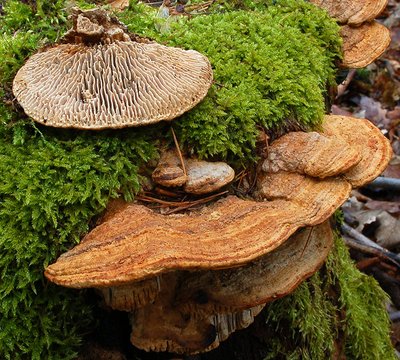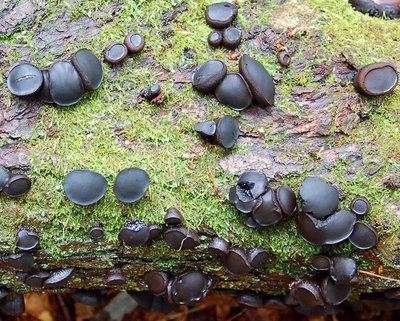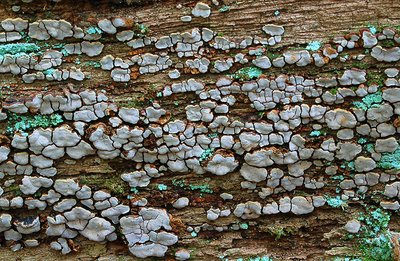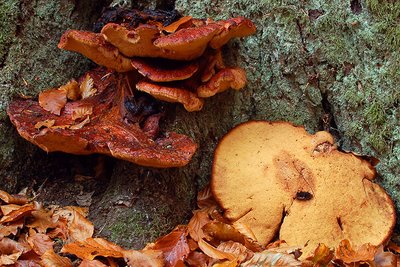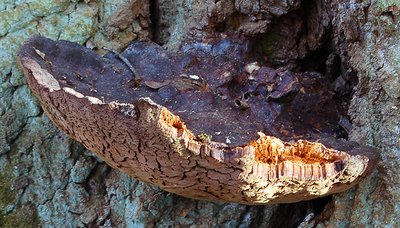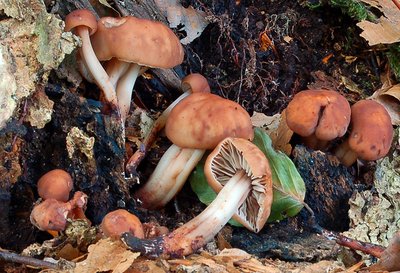More species of insects live on and in the oak than on any other indigenous tree species. It has more fungal companions than almost any other tree species in central European forests. These can be observed at all stages in the tree’s life, on anything from seedling to tree stump.
Insects - thermophilic fauna on the oak
From the big butterfly and beetle orders alone, a huge number of species have been shown to live on oak. 179 species of big butterflies and moths, more than 500 species of beetle and around 500 other phytophagous, mycetophagous and predatory species are known to live on oak. The oak can thus be seen to be one of the species-richest tree species of our native flora, although no distinction has been made up to now between the fauna on sessile oaks and that on pedunculate oaks.
Factors for diversity
This diversity is based on various factors. In terms of its evolutionary history, the Quercus genus is considerably older than our common or European beech (Fagus Genus), for example. After the last ice age, the oak also returned to Germany many thousands of years before the common beech, so that a longer phase of co-evolution was able to take place between the animal species and the oak. As the bark, wood, leaves and fruit of the oak all contain tannins, animals had to adapt specially to overcome this chemical defence mechanism. This is why there is such a striking number of monophagous species among the butterflies and beetles on oak.
The oak, and particularly the sessile oak (Quercus petaea), prefers warmer landscapes and occurs in those subject to lower precipitation. It penetrates further than the beech into sub-Mediterranean and sub-continental areas. Climatically warmer landscapes are generally richer in insects than cool-humid sites.
As one of the longest-living indigenous tree species, with some individual specimens more than 1000 years old, the oak offers a stable habitat. Old oaks thus form a bridge into the past, something which is also very favourable for species that hatch in cavities. Fungi break down the heartwood of older oaks with brown rot, without compromising the vital supply of water and nutrients. They thus create long-lasting hollow structures for species of insects, birds and bats. Trees with voluminous hollows are the rarest structural elements in our commercially used forests.
The oak is also a species that retains dead branches. It is possible to find significant quantities of dead branches and dead crownwood on living oaks. Up to 20 cubic metres of deadwood per hectare were measured on living reserve oaks in a coppice with standards. The oak fauna was thus also able to survive on the biotope trees even in times when there was very little deadwood, such as after the two world wars.
Beetles - the biggest beetles live on the oak
More than 1000 species of insect have been identified to date on oaks in central Europe. Single trees are also extremely rich in species and provide habitats for rare so-called relict species. Of the 115 "Urwald relict species" (species considered to be associated with primeval forest structures) in Germany, 66 species use the oak as a habitat. Many of the largest beetle species of central Europe develop on and in oak wood:
- Stag beetle (Lucanus cervus)
- Great capricorn beetle (Cerambyx cerdo, Fig. 3)
- Akimerus schaefferi (Akimerus schaefferi, Fig. 5)
- Hermit beetle (Osmoderma eremita)
- Flower chafer (Protaetia aeruginosa)
- Variable chafer (Gnorimus variabilis, Fig. 4)
- European rhinoceros beetle (Oryctes nasicornis, Fig. 2)
One of the most colourful ground beetles in Europe, the forest caterpillar hunter (Calosoma sycophanta), is as a caterpillar hunter also closely associated with oaks (Fig. 1) and the occurrence of the associated butterfly species, the gypsy moth (Lymantria dispar) and oak processionary (Thaumetopoea processionea).
16 species of bark beetle live on oak. The most common native species is the European oak bark beetle (Scolytus intricatus). In the crown structure of northern Bavarian oak forests, the Ambrosia beetle (Cyclorhipidion bodoanum), imported from eastern Asia, is the most common species. The most common bark beetle species at ground level in oak mixed forests is the black timber bark beetle (Xyleborus germanus), also from Asia.
A number of species of the genus of weevils or snout beetles Curculio develop in the acorns (Curculio glandium, venosus, pellitus and elephas) or in the galls of gall wasps on leaves and acorns (Curculio pyrrhoceras and villosus).
Jewel beetles are permanent members of the fauna community on oak. The forestry industry focuses here on the oak splendour beetle (Agrilus biguttatus) as a secondary pest. A further 16 jewel beetle species, some of which are highly endangered, also live on oaks.
Big butterfly species - magnificent, beautiful, but with a catch}
79 big butterfly species, including 30 monophagous species, are known to live on trees of the genus Quercus. Many of these are thermophilic or xerothermophilic so-called relict species, endangered in Germany.
Only two day-butterfly species develop on oak: the ilex hairstreak (Satyrium ilicis) and the purple hairstreak (Quercusia quercus, Fig. 6).
The owlet moths (Noctuidae), 63 species of which occur on oak, include the underwing or Catocala moths. The dark crimson underwing (Catocala sponsa), the light crimson underwing (Catocala promissa) and the brown underwing (Minucialunaris) are monophagous species that develop on oak.
59 species of geometer moths and 55 species of Bombycidae occur on oak, including six and ten monophagous species respectively. The Japanese oak silk moth (Antheraea yamamai) was imported into Slovenia for silk production and escaped from there into the wild (Fig. 7). Mass propagation of the gypsy moth (Lymantria dispar) and oak processionary (Thaumetopoea processionea) are nothing new: waves of mass propagation on a large scale were recorded as early as 1853.
Fungi – diversely shaped organisms accompanying oak trees from the seedling stage to the tree stump
Even acorns lying on the soil can be damaged by fungi. The black acorn blight (Ciboria batschiana) can destroy whole areas of sown oaks. The fungus forms small trumpet-like fruiting bodies that emerge in the autumn from the mummified acorns of the previous year.
In the first few years and especially just after planting, oak are very susceptible to infection with fungi of the genus Hallimasch Armillaria sp.
Oak root rot can also be disastrous for young oaks, as the trees at that (young) age are barely able to withstand the damage. This root rot can be caused by several fungus species. Infestation with Cylindrocarpon destructans is the most conspicuous. Its cream coloured sporocarps are easily discernible to the naked eye on the surface of the root. These fungus species only occur more often, however, when the oak has suffered previous damage, for example if the root has been trimmed too severely, or in extreme dry or wet periods.
Different species of the Phytophthora genus can also cause severe damage to the roots of the oak. These parasites destroy lots of fine roots in particular, thus disrupting the trees’ intake of water and nutrients. Above-ground symptoms on the oak caused by Phytophthora are only seldom to be observed.
Many leaf fungi are to be found on the leaves of the oak. Many of them live as endophytes in the leaves, initially without causing apparent symptoms. Oak anthracnose, caused by Apiognomonia quercina, is among the most frequently occurring form of leaf spot disease. First of all, irregular, light brown leaf spots appear on the leaves. The main fungal fruiting bodies do not form until the following year, on fallen leaves on the ground, when fresh new leaves are again expanding on the trees and can also be infected.
The best known leaf fungus is almost certainly the oak mildew Erysiphe alphitoides Syn. Microsphaera alphitoides (Fig. 8). What is special about this fungus is that its hyphae system is immediately obvious, with the mycelium developing mainly on the leaf and penetrating from there to infect the cells of the leaves. The typical white powdery mildew on the leaves and twigs is formed by the vast amounts of hyphae. This makes the oak mildew easy to recognise in summer and autumn. Oak mildew is very host-specific and affects only the oak.
The lip-shaped fruiting bodies of the Colpoma fungus (Colpoma quercinum) regularly appear on thin oak branches. This is one of the first decomposers, and occurs in almost all oak stands that have grown beyond the cultivation stage.
A multitude of fungal fruiting bodies of all sorts of different shapes occur on oak trunks. There are the extremely hard, brown, long lasting and also perennial fruiting bodies of the robustus conk (Phellinus robustus, Fig. 9). The shelf-like fan-shaped fruiting bodies of the oak mazegill (Daedalea quercina, Fig. 10) are also unmistakeable. Very different to this fungus is the black Bulgar, also known as bachelor’s buttons (Bulgaria inquinans), with its gum or button-like black fruiting bodies (Fig. 11).
The ceramic fungus, also known as ceramic parchment (Xylobolus frustulatus) adds a new layer each year to its perennial, frustose (= cracking into small, angular polygons) bark fungus crust (Fig. 12). The fungus prefers thicker oak wood and often occurs on sections of trunk that have been left in the forest. It is thus considered to be an indicator of near-natural forests, as is the lion’s mane mushroom (Hericium erinaceus). The latter forms its fruiting bodies on old, ailing oaks and beech or on thick pieces of lying deadwood of these two species.
The rare hen of the woods or ram’s head mushroom (Grifola frondosa) and the lumpy bracket or umbrella polypore (Dendropolyporus umbellatus) are also oak colonisers. If cooked thoroughly, the crab of the woods bracket fungus (Laetiporus sulphureus) is considered edible, although its shelf-like fruit bodies absorb so many tannins from the oak that they are often bitter. The fungus with the biggest fruiting body in Germany, the giant polypore (Meripilus giganteus), can also occur on the oak. The rot caused by this fungus on the roots of the oak may cause the tree to fall unexpectedly.
The beefsteak fungus or ox tongue fungus (Fistulina hepatica, Fig. 13) forms a very characteristic fruiting body. The meaty, reddish shelf-like fruiting bodies of the mushroom not only look like a tongue, but also have a fibrous consistency and "bleed" a dull red juice when cut.
The oak bracket, (synonyms warted oak polypore, weeping polypore or weeping conk) (Inonotus dryadeus) begins to grow out of the bark in the summer as a fist-sized conk oozing with hundreds of orange-brown droplets. It can grow to over 60 cm in width, and in winter it is often reminiscent of the perennial fruit bodies of the artist’s conk (Ganoderma applanatum) (Fig. 14).
Many gilled mushrooms live on the oak in the course of the decay of the wood. One typical representative of these is the clustered bonnet or oak-stump bonnet cap (Mycena inclinata). The Gymnopus fusipes (Collybia fusipes) can also occur at the base of the trunk in oak (Fig. 15). The appearance of its fruiting bodies is an indicator of damage to the oak’s root system.
The dreaded brittle cinder fungus (Kretzschmaria deusta), a sac fungus or ascomycete, can also be a problem affecting oak from time to time. Its black, cinder-like fruiting bodies are difficult to identify in the thick bark of the oak. Once it appears, the fungus has already caused significant decay in the wood.
Many species are very closely connected with the oak as mycorrhiza fungi. These include the red-capped scaber stalk (Leccinum quercinum), the purple brittlegill (Russula atropurpurea), the oak milkcap (Lactarius quietus), the summer cep (Boletus reticulatus) or the death cap (Amanita phalloides).
Oaks - important for biodiversity
In Bavaria’s forests, oaks are important pillars of species-diversity and thus play a key role in maintaining biodiversity in Bavaria. Often artificial regeneration of the oak is necessary through seed propagation or planting, or it may be necessary in deciduous forests to allow the oak to compete with the dominant common beech.
Literature
Article from LWF Wissen 75 (german only):
- Bußler, H. (2014): Käfer und Großschmetterlinge an der Traubeneiche. LWF Wissen 75, S. 89 – 93. (PDF, 316 KB)
- Blaschke, M.; Nannig, A. (2014): Pilze an Eiche. LWF Wissen 75, S. 94 – 97. (PDF, 480 KB)

